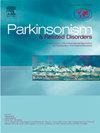帕金森病的症状发作偏侧和双侧:运动和非运动特征的临床意义
IF 3.4
3区 医学
Q2 CLINICAL NEUROLOGY
引用次数: 0
摘要
背景:虽然运动症状不对称是帕金森病(PD)的一个标志,但症状发病侧性的临床相关性,特别是与利手性和双侧发病有关的临床相关性仍未得到充分探讨。目的探讨帕金森病的症状起病模式——右与左、显性与非显性、双侧与单侧——与运动与非运动临床特征的关系。方法对460例PD患者进行回顾性分析。发病侧、利手性有历史记录;标准化评估包括MDS-UPDRS、HY、NMSS和PDQ-39。多因素logistic回归确定了发病侧的独立相关因素。结果右侧发病预测较高的ON-state运动负荷(MDS-UPDRS Part 3; OR = 1.48, 95% CI 1.05-2.09, p = 0.025)。优势侧发病也有类似的关联(OR = 1.46, 95% CI 1.04-2.06, p = 0.029)。双侧发病-在4%的队列中观察到,但通常被排除在先前的研究之外-显示出不同的特征:动力学刚性表型(OR = 2.13, p = 0.008), HY期≥3 (OR = 2.40, p = 0.025),以及NMSS更大的情绪/认知负担(OR = 2.36, p = 0.022)。相反,双侧发病与OFF-state MDS-UPDRS Part 3评分呈负相关(OR = 0.31, p = 0.029)。结论PD症状性侧化具有临床意义。尽管进行了多巴胺能治疗,但优势侧发病标志着较高的残余运动障碍,而双侧发病标志着更严重的非震颤显性表型,并伴有显著的情绪认知参与。系统地纳入双侧病例和考虑偏手性可加强患者分层,并可为预后咨询和治疗计划提供信息。本文章由计算机程序翻译,如有差异,请以英文原文为准。
Symptom onset lateralization and bilaterality in Parkinson's disease: Clinical implications of motor and non-motor profiles
Background
Although motor symptom asymmetry is a hallmark of Parkinson's disease (PD), the clinical relevance of symptom-onset laterality—particularly with respect to handedness and bilateral onset—remains underexplored.
Objective
To determine how symptom-onset patterns—right vs. left, dominant vs. non-dominant, and bilateral vs. unilateral—relate to motor and non-motor clinical features in PD.
Methods
We retrospectively analysed 460 PD patients. Onset side and handedness were recorded from history; standardised assessments included MDS-UPDRS, HY, NMSS, and PDQ-39. Multivariate logistic regression identified independent correlates of onset side.
Results
Right-sided onset predicted higher ON-state motor burden (MDS-UPDRS Part 3; OR = 1.48, 95 % CI 1.05–2.09, p = 0.025). A similar association was seen for dominant-side onset (OR = 1.46, 95 % CI 1.04–2.06, p = 0.029). Bilateral onset—observed in 4 % of the cohort yet often excluded from prior studies—displayed a distinct profile: akinetic-rigid phenotype (OR = 2.13, p = 0.008), HY stage ≥3 (OR = 2.40, p = 0.025), and greater mood/cognition burden on the NMSS (OR = 2.36, p = 0.022). Conversely, bilateral onset was inversely related to OFF-state MDS-UPDRS Part 3 scores (OR = 0.31, p = 0.029).
Conclusions
Symptom-onset lateralization in PD carries clinically meaningful implications. Dominant-side onset signals higher residual motor impairment despite dopaminergic therapy, whereas bilateral onset marks a more advanced, non-tremor–dominant phenotype with prominent mood–cognition involvement. Systematic inclusion of bilateral cases and consideration of handedness enhance patient stratification and may inform prognostic counseling and therapeutic planning.
求助全文
通过发布文献求助,成功后即可免费获取论文全文。
去求助
来源期刊

Parkinsonism & related disorders
医学-临床神经学
CiteScore
6.20
自引率
4.90%
发文量
292
审稿时长
39 days
期刊介绍:
Parkinsonism & Related Disorders publishes the results of basic and clinical research contributing to the understanding, diagnosis and treatment of all neurodegenerative syndromes in which Parkinsonism, Essential Tremor or related movement disorders may be a feature. Regular features will include: Review Articles, Point of View articles, Full-length Articles, Short Communications, Case Reports and Letter to the Editor.
 求助内容:
求助内容: 应助结果提醒方式:
应助结果提醒方式:


